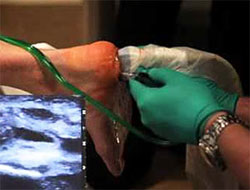- Home
- Advanced Treatments
- Tenex
Tenex Procedure
- Published 11/27/2018
- Last Reviewed 3/7/2024

If you’re one of 8 million Americans experiencing pain and discomfort in the Achilles tendon and/or plantar fascia, the Tenex Health Procedure, a minimally invasive treatment for soft tissue damage, may help.
Developed with Mayo Clinic, Tenex Health created a new conservative tendon procedure to help remove damaged tissue and leave behind healthy tissue, reducing tendon pain, aiding healing, and reducing the likelihood of more invasive treatment in the future.
- What can cause fascia discomfort or tendon pain?
- How are Achilles tendinopathy and plantar fasciitis traditionally treated?
- What is the Tenex procedure?
- The TenJet System: a new and better alternative to Tenex?
- What is the TenJet procedure?
- Why Turn to UFAI for your TenJet or Tenex procedure
- Tenex FAQs
- What is the success rate of Tenex? TenJet?
- Is Tenex better than PRP?
- What is the difference between Tenex and TenJet?
-
Foot and Ankle Surgeon at University Foot and Ankle Institute
Dr. Justin Franson, DPM, is a Board Certified Podiatric Foot and Ankle Specialist and Diplomate of the American Board of Podiatric Surgery. He attended the School College of Podiatric Medicine in Chicago, graduating in 2001. Dr. Franson then accepted a three-year residency program at the Greater Los Angeles VA and UCLA County Hospital.
Dr. Franson specializes in several areas including total ankle replacement and sports medicine. Treating athletes and weekend warriors like himself brings him a lot of joy. Dr. Franson keeps active with running marathons, triathlons, hiking, basketball, and golf.
Read more about Tenex on Our Blog
 Such a great practice. I have had nothing but amazing visits with Doctor Bob and the staff. Dr. Bob has such a great personalit...Jason L.
Such a great practice. I have had nothing but amazing visits with Doctor Bob and the staff. Dr. Bob has such a great personalit...Jason L. I liked it.Liisa L.
I liked it.Liisa L. Dr. Baravarian and staff were all very friendly, professional, and helpful in prescribing the best treatments for my injury.Victor S.
Dr. Baravarian and staff were all very friendly, professional, and helpful in prescribing the best treatments for my injury.Victor S. I depend on the doctors at UFAI to provide cutting edge treatments. Twice, I have traveled from Tucson, Arizona to get the car...Jean S.
I depend on the doctors at UFAI to provide cutting edge treatments. Twice, I have traveled from Tucson, Arizona to get the car...Jean S. They helped me in an emergency situation. Will go in for consultation with a Dr H????
They helped me in an emergency situation. Will go in for consultation with a Dr H????
Re foot durgeryYvonne S. It went very smoothly.Maria S.
It went very smoothly.Maria S. My experience at the clinic was wonderful. Everybody was super nice and basically on time. Love Dr. Bavarian and also love the ...Lynn B.
My experience at the clinic was wonderful. Everybody was super nice and basically on time. Love Dr. Bavarian and also love the ...Lynn B. Dr Franson and his staff in the Santa Clarita office are very professional and patient oriented. He treated me for a toe nail ...Vicky R.
Dr Franson and his staff in the Santa Clarita office are very professional and patient oriented. He treated me for a toe nail ...Vicky R. I fill I got the best service there is thank youJames G.
I fill I got the best service there is thank youJames G. My experience with your practice far exceeded any of my expectations! The staff was always friendly, positive and informative. ...Christy M.
My experience with your practice far exceeded any of my expectations! The staff was always friendly, positive and informative. ...Christy M. Love Dr. Johnson.Emily C.
Love Dr. Johnson.Emily C. I am a new patient and felt very comfortable from the moment I arrived to the end of my visit/appointment.Timothy L.
I am a new patient and felt very comfortable from the moment I arrived to the end of my visit/appointment.Timothy L.

